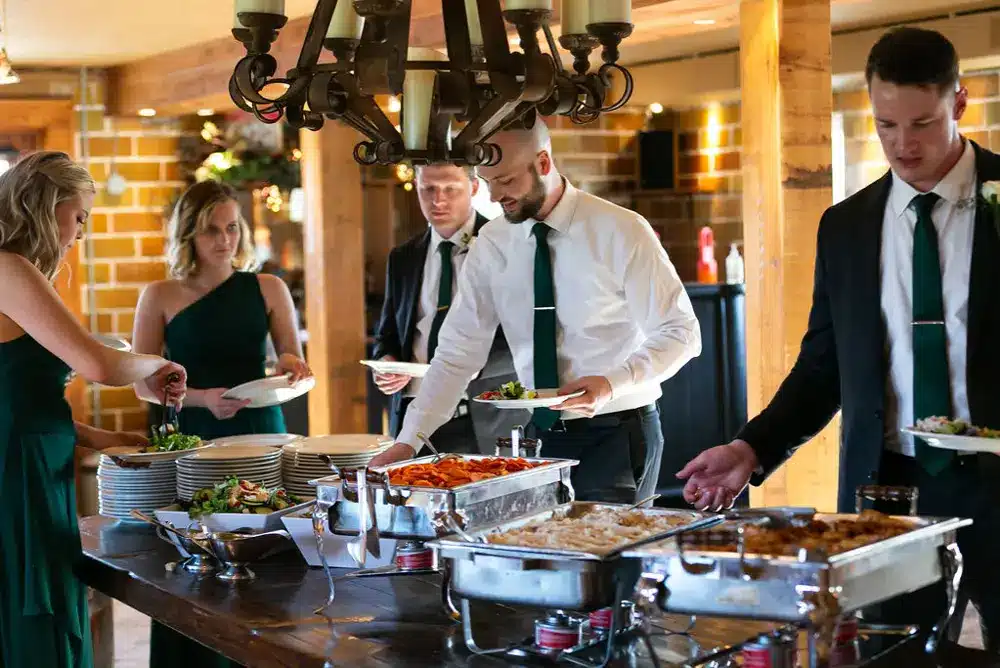Photo by: Engage Me Photography
Your wedding day is a celebration of love, commitment, and shared joy with family and friends. Among the myriad of decisions you’ll make in planning your special day, choosing the right food service style is crucial. From elegant plated dinners to interactive food stations, each service style offers its own unique charm and benefits. In this guide, we’ll explore four popular wedding food service styles—buffet, plated, family style, and food stations—and help you determine which one is the perfect choice for your celebration.
1. Buffet
Buffet-style service involves guests serving themselves from a selection of dishes arranged on one table. Guests typically line up and fill their plates with the items of their choice.
Pros
- Variety: Buffets offer a wide array of dishes, catering to diverse tastes and dietary preferences. Guests have the freedom to choose exactly what and how much they want to enjoy for their meal.
- Flexibility: Buffets accommodate larger guest counts more easily than plated service, making them ideal for large weddings.
- Interactive: Guests enjoy the opportunity to customize their meal and mingle with others while selecting their food.
Cons
- Potential for Waste: With guests serving themselves, there’s a risk of overestimating the amount of food needed, leading to waste.
- Queueing: Buffet lines can result in congestion and longer wait times, particularly if there’s limited space or inefficient organization.
2. Family Style
Family-style service combines the elements of both buffet and plated service, with large platters of food brought to each table for guests to serve themselves.
Pros
- Shared Experience: Family-style dining encourages guests to interact and bond over passing dishes around the table, fostering a sense of community.
- Flexibility: Similar to buffets, family-style service allows guests to choose their portions and accommodate dietary preferences.
- Enhanced Presentation: Large platters of food can create a visually appealing centerpiece for each table, enhancing the overall aesthetic of the reception.
Cons
- Space Considerations: Family-style service requires ample table space to accommodate the serving platters, which may not be feasible for all venues or table layouts.
- Coordination Required: Effective coordination is essential to ensure timely delivery of food to each table and prevent congestion or delays.
- Potential for Disruption: Guests may need to pass dishes around, potentially disrupting conversations or requiring additional movement.
3. Food Stations
Food stations offer a dynamic and interactive dining experience, with different stations set up throughout the reception area, each featuring a specific cuisine or type of dish.
Pros
- Customization: Food stations allow for customization and creativity, with the ability to offer a diverse range of cuisines and flavors to suit every palate.
- Engagement: Guests enjoy the interactive aspect of visiting different food stations, engaging with chefs, and watching their meals being prepared.
- Flow and Movement: Food stations help distribute guests throughout the reception space, preventing congestion and encouraging movement and exploration.
Cons
- Coordination Challenges: Managing multiple food stations requires careful coordination to ensure a smooth flow of service and prevent bottlenecks.
- Space Requirements: Depending on the number of stations and guest count, food stations may require significant space, impacting venue selection.
4. Plated
Plated service involves guests being served individual portions of each course by waitstaff. Meals are typically pre-selected by guests through RSVPs.
Pros
- Elegant Presentation: Plated dinners are synonymous with elegance and sophistication, adding a touch of refinement to your wedding reception.
- Controlled Portions: With predetermined portion sizes, plated service helps minimize food waste and ensures consistency in presentation.
- Efficient Service: Guests can focus on enjoying the company of others without having to queue for food, as waitstaff delivers each course directly to their tables.
Cons
- Limited Choices: Plated dinners typically offer a set menu with limited options, which may not cater to all dietary restrictions or preferences.
- Longer Service Time: Serving each course individually can prolong the dining experience, potentially extending the duration of the reception.
- Higher Cost: Plated service often requires more staff and coordination, resulting in higher labor costs compared to other service styles.
Choosing the perfect wedding food service style involves considering factors such as guest count, venue constraints, budget, and desired atmosphere. Whether you opt for the interactive experience of food stations, the elegance of plated dinners, the communal feel of family-style dining, or the versatility of buffets, each service style offers its own unique benefits and considerations. By carefully weighing the pros and cons of each option, you can select the perfect food service style to complement your wedding vision and create an unforgettable dining experience for you and your guests.
Contact us at Sterling Catering to learn more about how we can help you create the wedding reception of your dreams. When you choose us as your caterer, we are now on your team and will go above and beyond to make your menu delicious, presentation stunning, and reception an overall success. Still not sure which style is best for you? Don’t worry, we can help you every step of the way!


